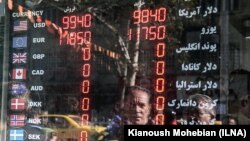The U.S. dollar is again on a steep rise in Iran. The greenback climbed to over 130,000 rials on Monday morning February 18. This is the biggest rise for the dollar in Iran's government-controlled forex market during the past three months.
The rate of exchange for the U.S. dollar was 11,000 rials on December 31. The new rate is still well below the rate of 190,000 rials per dollar in the summer of 2018.
The Iranian currency entered a sharp devaluation period almost a year ago when markets concluded that the Unites States would pull out of the 2015 nuclear agreement and reimpose economic sanctions.
As the dollar rose so did gold, as the two move in tandem; both being sought-after safe-havens.
Market observers attribute the high price of foreign currencies and gold to uncertainty about the fate of the bills against money laundering and combating terrorism financing, which are required by the Financial Action Task Force (FATF) to exclude Iran from its blacklist.
If Iran refuses to adopt the required financial legislation this week, FATF might downgrade Iran to its blacklist, with more negative consequences for the country's banking and trade relations.
The rise in the price of gold could also be partly attributed to the arrival of the Iranian New Year in late March when gold is a popular New Year gift for those who can afford it.
Meanwhile, the governor of the Central Bank of Iran, Abdolnasser Hemmati on his Instagram page acknowledged the rise in prices, adding that "The Central Bank will take necessary measures if needed." However, he did not say what the bank was going to do.
At the same time, the price of Iranian-made vehicles in the Iranian markets has risen between 20,000,000 to 40,000,000 rials during the past few days. The cheapest Iranian-made car, Pride, which is said to be a modified version of Korean vehicle KIA, has risen to 470,000,000 rials ($3,600 based on current open market rate) within two days, with a 40,000,000 hype ($300).
During the past week car buyers in Iran have been protesting in front of vehicle manufacturing companies against an unusual price rise. The protesters paid the price of the cars they bought several months ago, and in some cases more than a year ago, but the companies have been demanding more money on delivery date.
In an interview with Tasnim news agency, one car manufacturer attributed the rise in the price of cars to manipulation of the market by profiteers. He said the prices should not rise considering a 90 percent increase in car production during recent months. However, he did not offer any evidence for the claim.
On the other hand, SAIPA, one of the car manufacturers says the new prices are up to five percent below the market rates; an argument that does not explain why those who have already paid for the car they bought need to pay more.
Hardline news website Mashregh News quoted SAIPA's former managing Director Mohammad Reza Soroush as having said that the price rise has been suggested by the Ministry of Industry, Mining and Trade based on political motivation, which could mean making President Hassan Rouhani look bad.
Meanwhile, in an unusual change in its policy, hardliner-controlled Iranian state TV has also criticized the price rise; an action which adds to the possibility of political motivations in manipulating the markets.
According to the economic news website Eghtesad Online, a limited supply of cars in the market, manipulation of markets by dealers and middlemen, as well as lack of proper supervision on the car market are among the reasons for rising prices. This contradicts the claim that car production has increased 90 percent.
Eghtesad Online also reported on problems in another sector of Iran's troubled economy, saying that the country's housing market is short of 4,000,000 units.
The news website added that annually Iran needs one million new residential units, while currently only 300,000 to 370,000 houses are built. The website said that the government is incapable of providing housing to first-time buyers although there are some 2,000,000 vacant houses which are not put on the market for sale or rent.
Due to unusual risks and fluctuations in the investment market, some Iranians turn to buying houses and keeping them vacant in the hope of further rise in prices. Investing in real estate is a good way to protect money from devaluation.
Mohammad Reza Rezai, Chairman of the Iranian Parliament's Development Committee recently called on wealthy institutions such as the administration of the holy shrine in Mashad to invest in building houses in order to make up for the government's inability to offer cheap housing to new buyers.
According to the latest reports on the situation of housing in Tehran where nearly one fifth of the country's population lives, residential real estate prices in Tehran have risen 54.4 percent between July 2017 and July 2018, according to the Central Bank of Iran.
In its latest report on the capital city’s housing market, CBI also reported that the price per square meter for Tehran residential units increased to 69.7 million rials (roughly $1,600).






